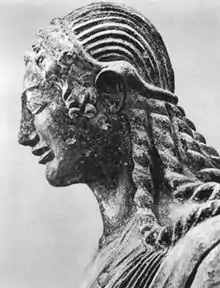_01.jpg.webp)
An Etruscan impasto amphora, Louvre.
Impasto is a type of coarse Etruscan pottery. The defining characteristic is that the clay contains chips of mica or stone.[1]
In G.A. Mansuelli's, The Art of Etruria and Early Rome (1964), the term "impasto pottery" is described in the following way: "Ceramic technique characteristic of hand-worked vases. By 'impasto pottery' is generally meant that of pre-historic times, of the Iron Age or later, made of impure clay with silica content." (p. 236)
See also
Wikimedia Commons has media related to Impasto.
References
- ↑ Nigel Spivey, Etruscan Art, page 35
This article is issued from Wikipedia. The text is licensed under Creative Commons - Attribution - Sharealike. Additional terms may apply for the media files.
